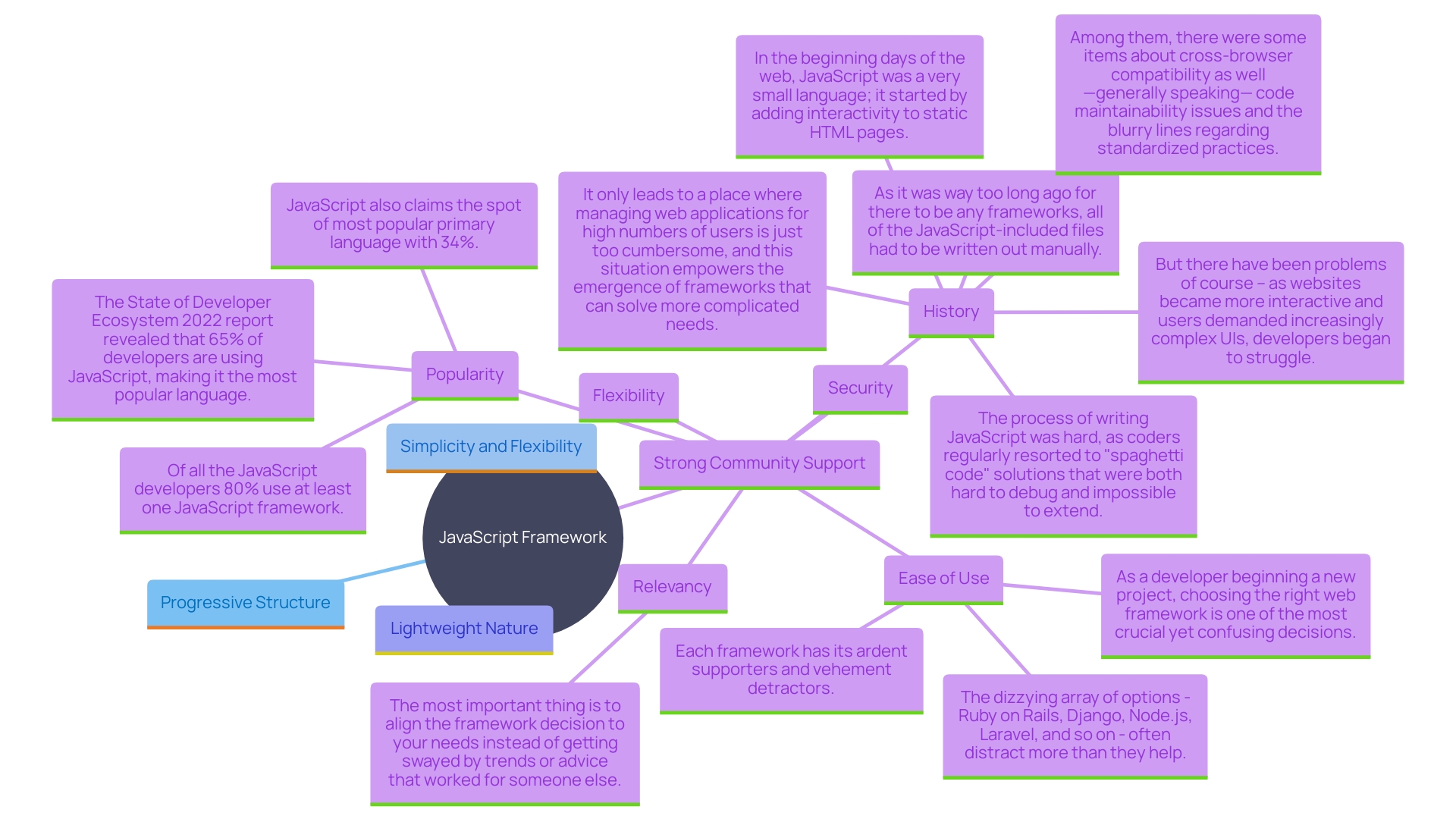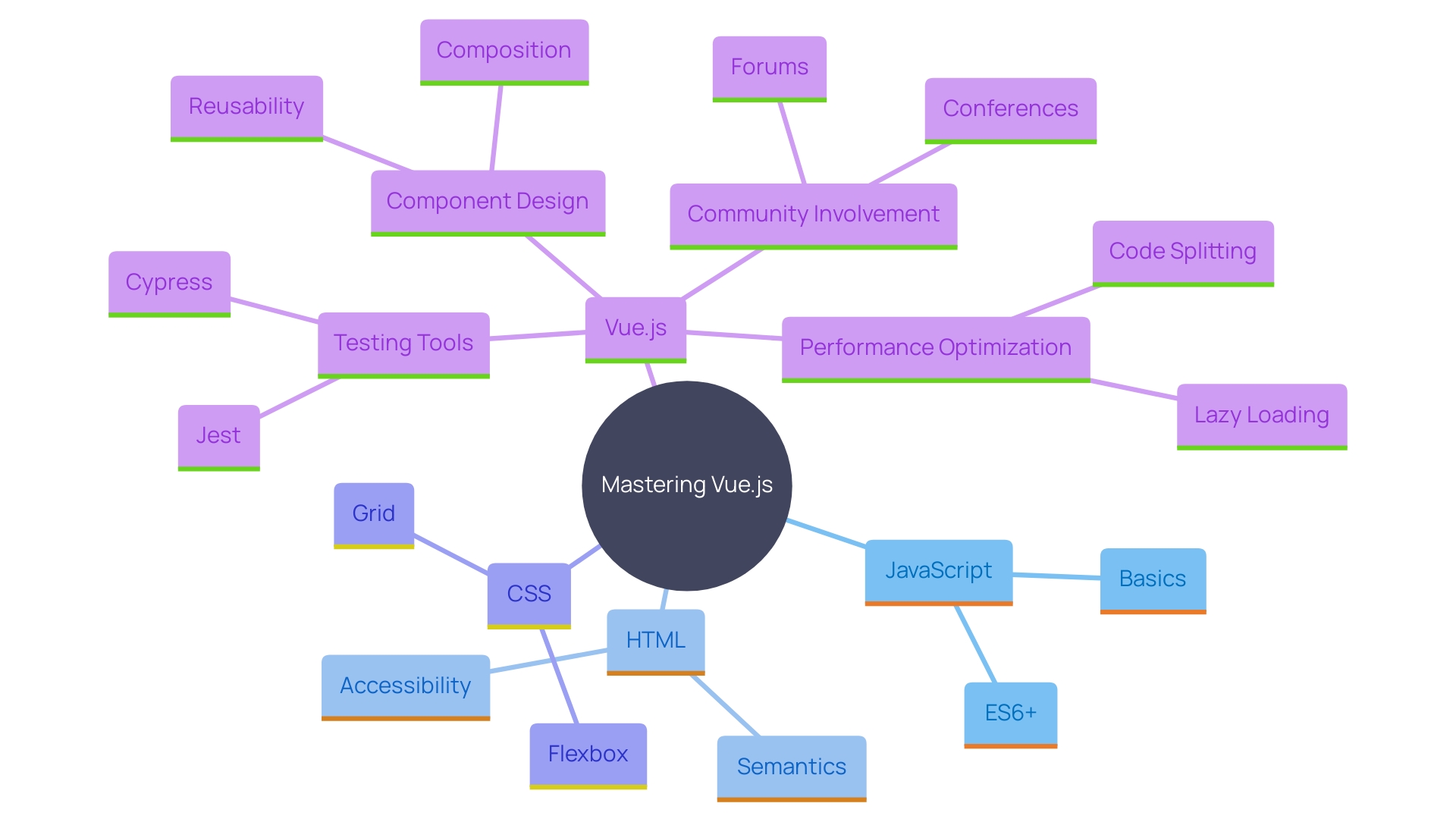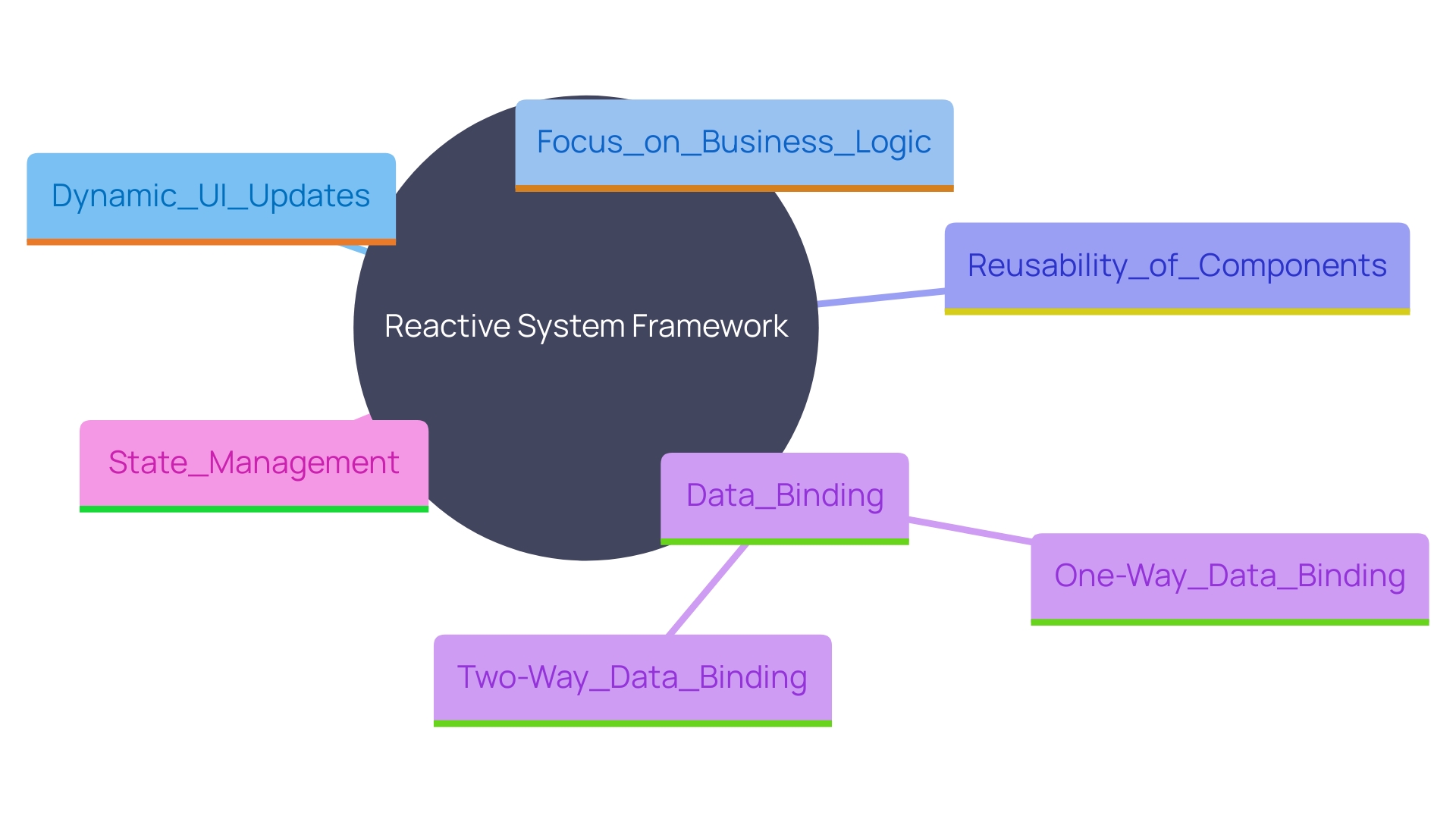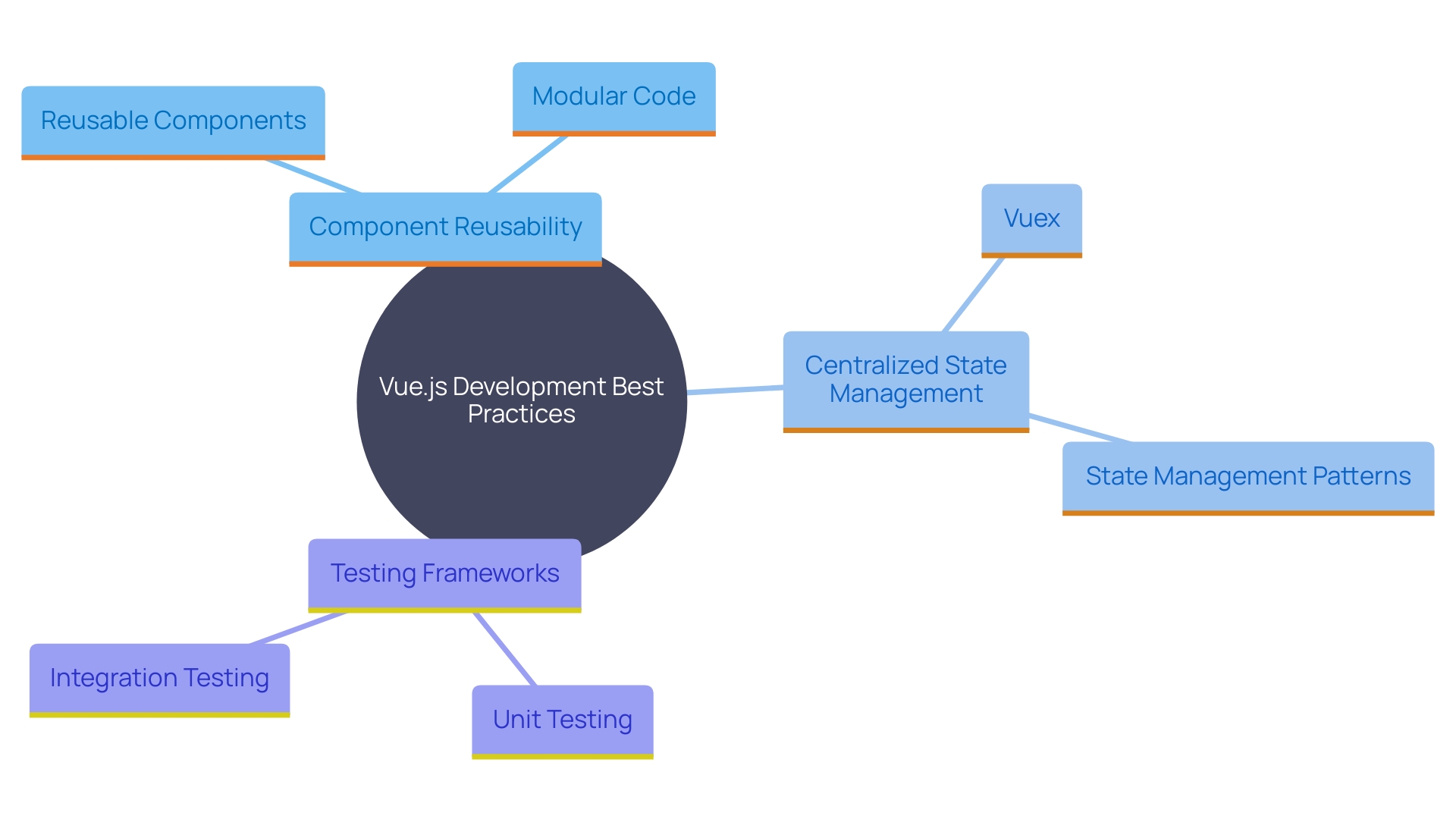Introduction
Vue.js has emerged as a powerful tool in the realm of web development, celebrated for its simplicity and versatility in creating interactive user interfaces. Originating from the innovative mind of Evan You, Vue.js integrates the best elements of Angular with an accessible learning curve, making it a preferred choice for both novice and seasoned developers. This article delves into the essential aspects of Vue.js, exploring its key features, reasons for its widespread adoption, and the core skills required to master this progressive JavaScript framework.
Additionally, the discussion extends to advanced topics such as component architecture, reactivity and data binding, state management with Vuex, and routing with Vue Router, providing a comprehensive guide for developers aiming to leverage Vue.js for modern application development.
Key Features of Vue.js
'Vue, commonly known as Vue, is a progressive JavaScript framework aimed at building user interfaces.'. Created by Evan You, who identified the need for a lightweight framework while working at Google, Vue.js merges the best aspects of Angular with a simpler learning curve. This has led to its widespread adoption due to its simplicity, detailed documentation, and ease of use.
Vue's main emphasis is on the view layer, allowing creators to build sophisticated, interactive web experiences. Key features include a reactive data-binding system, which ensures that the view automatically updates when the data changes. Its component-based architecture allows for reusable and encapsulated components, making code more maintainable and scalable. Furthermore, Vue's ecosystem facilitates state management and routing, rendering it a comprehensive solution for constructing intricate systems.
One of Vue's standout advantages is its incremental adaptability, enabling individuals to incorporate it gradually into existing projects. This flexibility makes Vue an excellent option for both small-scale projects and large enterprise solutions. With its forward-thinking characteristics, this framework continues to enable developers to create contemporary, high-performing web solutions effectively.
Why Choose Vue.js for Modern Applications
The JavaScript framework stands out in contemporary application development due to its progressive structure, which balances simplicity and flexibility. Originating from Evan You's experience with AngularJS at Google, this framework was designed to combine data-binding and a component-based approach with a gentler learning curve. This makes it accessible for newcomers while offering robust capabilities for seasoned developers. Its lightweight nature ensures faster performance, and the extensive documentation and community-driven ecosystem provide a wealth of resources and tools. This mix of characteristics has made this framework a favored option for developing dynamic, interactive web solutions.

Essential Skills for Vue.js Development
'To excel in this JavaScript framework development, mastering JavaScript is crucial, as it forms the backbone of this progressive framework created by Evan You.'. Vue.js merges the best features of Angular with an easier learning path, making it perfect for creating rich and interactive web experiences. Familiarity with HTML and CSS is equally important, as these are the foundational pillars of web development. Additionally, understanding component design, which allows for a modular approach to building user interfaces, is essential. 'Vue Router enables smooth navigation within systems, and Vuex is essential for state management, ensuring data consistency across components.'.
Optimizing performance is another key area, as it directly impacts the user experience. Techniques such as lazy loading, code splitting, and efficient data handling are vital for maintaining fast and responsive software. Implementing testing is also crucial to identify and fix bugs early in the development process. Tools like Jest and Vue Test Utils can be used to ensure robust and reliable code.
With Vue's ease of use, thorough documentation, and smooth learning progression, programmers can swiftly adjust and excel in creating contemporary web solutions. As Mariam, an international speaker and expert in Vue, often emphasizes, contributing to the community through blogs and conferences can further enhance one's expertise and keep skills up-to-date.

Understanding Vue.js Components
Components are the building blocks of applications, functioning as self-contained units that encapsulate their own structure, behavior, and styling. This modular approach aligns with the concept of composable architecture, where software systems are built from small, independent components that can be combined to form a complete system. For instance, in a project setting up a simple form to allow users to set their desired work and break times, Vue’s @submit. Prevent was used to stop the form from refreshing the page, and v-model allowed for easy data binding and manipulation of input values. This modularity not only promotes reusability and easier maintenance but also facilitates the independent development, testing, and updating of each component. 'Experienced business analysts and programmers appreciate Vue’s simplicity and detailed documentation, which make it accessible while maintaining robust functionality.'. As noted by experts, using props to pass arguments to a component customizes its behavior and appearance, further enhancing the versatility and reusability of components. Therefore, mastering the creation of reusable components and managing their lifecycle is fundamental to effective development, enabling programmers to deliver modular and maintainable code efficiently. This approach is exemplified by the shift towards tools like Vite, which, driven by active development within the Vue ecosystem, offer fast and lightweight solutions, essential for modern, complex user interfaces.
Reactivity and Data Binding in Vue.js
The framework employs a reactive system that dynamically updates the user interface whenever data changes, streamlining the development process. This reactivity allows developers to concentrate on business logic without the need for manual DOM manipulation. For example, consider a simple greeting component that initially displays 'Hello, John'. By using props from this framework, this component can be easily modified to accept different names, enhancing reusability across various scenarios. The framework provides both one-way and two-way data binding, offering adaptability to meet various program needs. This dual binding capability ensures that data remains synchronized between the model and the view, simplifying state management and enhancing user experience.

State Management with Vuex
Vuex, a state management library designed for Vue.js projects, plays a critical role in the seamless operation of complex systems. By centralizing the software's state, Vuex simplifies the management of state changes through its systematic use of actions, mutations, and getters. This centralized control not only makes the software's behavior more predictable but also easier to debug.
Understanding and effectively using Vuex is indispensable when multiple components need to share and synchronize state. This becomes especially crucial in larger, more intricate projects where state consistency and performance can significantly impact the user experience. By clearly defining different program states and transitions between them, Vuex ensures a robust and maintainable structure.
As an experienced developer, I can attest to the importance of mastering state management tools like Vuex. During my tenure leading front-end teams at Kaltura, I have seen firsthand how centralized state management can transform the development process, making it more efficient and sustainable. 'Vuex stands out for its ability to handle complex state logic predictably and maintainability, which is essential for any software aiming for maturity and optimal performance.'.
Routing with Vue Router
Vue Router, the official routing library for Vue.js, is crucial in developing single-page experiences (SPEs) with dynamic routing features. It empowers developers to map routes to components with ease, manage seamless navigation, and handle route transitions effectively. This functionality significantly improves the user experience by enabling smooth and interactive web interfaces. As the framework itself was designed to be progressive and adaptable, Vue Router complements this vision by providing a straightforward yet powerful tool for building complex Spas. This integration assists creators in providing a rich and responsive user interface, ensuring that web solutions not only operate effectively but also feel intuitive and engaging for users.
Best Practices for Vue.js Development
'To ensure high-quality Vue.js projects, programmers should adhere to best practices that enhance code maintainability and performance.'. Component reusability stands at the forefront, where developers can break down the template into distinct, dedicated components. This approach not only simplifies the development process but also facilitates independent testing of each component. Maintaining a centralized state with Vuex is another essential practice, effectively managing the state throughout the system and making the code more predictable and easier to debug. Utilizing Vue Router efficiently ensures seamless navigation and a better user experience by dynamically mapping components to routes.
Writing clean, maintainable code is paramount, and this can be achieved by consistently refactoring the codebase to improve its structure without altering its functionality. Refactoring enhances readability, makes the system easier to modify, and boosts overall performance. 'Utilizing testing frameworks is crucial to guarantee that the software operates properly and upholds high performance standards.'. These frameworks enable programmers to automate testing processes, swiftly identify bugs, and confirm that new features do not disrupt existing functionalities.
By incorporating these methods, developers can utilize the framework to create strong, scalable, and easy-to-manage software. As Evan You, the creator of Vue.js, emphasized, 'Vue.js combines the best aspects of Angular with a simpler learning curve,' making it an ideal choice for developing interactive web applications.

Conclusion
Vue.js has solidified its position as a leading framework for modern web development, primarily due to its simplicity, versatility, and comprehensive feature set. The framework's reactive data-binding system, component-based architecture, and incremental adaptability empower developers to create complex applications with ease. By merging the best elements of Angular with a gentler learning curve, Vue.js offers a seamless entry point for both newcomers and experienced developers alike.
The importance of mastering essential skills, such as JavaScript, HTML, and CSS, cannot be overstated. Additionally, understanding the intricacies of Vuex for state management and Vue Router for routing ensures that developers can build robust applications that maintain data consistency and provide an intuitive user experience. Emphasizing component reusability and efficient performance optimization further enhances the overall quality of applications built with Vue.js.
Adhering to best practices in Vue.js development is crucial for creating maintainable and scalable applications. By focusing on clean code, effective state management, and thorough testing, developers can leverage Vue.js to its fullest potential. As the demand for interactive web applications continues to grow, embracing Vue.js not only equips developers with the necessary tools but also positions them at the forefront of modern web development.





